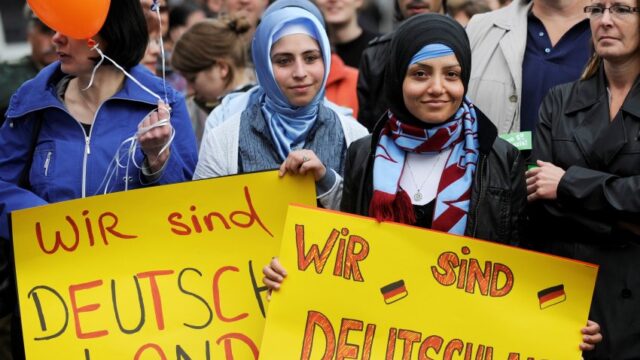Hamburg District Shows the Dark Side of Multiculturalism

The infamous Phoenix district in south Hamburg is grappling with a multitude of issues, including drug trafficking, illegal gambling, and frequent violence, with mass immigration transforming the neighborhood in recent decades.
It is not a right-wing conspiracy theory that the district is crime-ridden. German state media outlet NDR recently reported a surge of police in the area, writing: “A fatal balcony fall, mass brawls, knife stabbings, and repeated drug incidents: the Phoenix district in Hamburg-Harburg has often been in the headlines in recent weeks. Now, the police want to show an increased presence there.”
However, the neighborhood was not always a cesspit of crime. An interview conducted by Welt involving a kiosk owner in the area shows the deleterious and slow-motion disaster that multiculturalism and mass immigration all too often bring about.
“Everyone comes to me,” says Marlies Kurtz, a Thuringian native who opened her convenience kiosk shop on Maretstrasse 35 years ago. “The nice people, the junkies, and even those I usually avoid – they still show me respect.” As Welt reports, her kiosk sits at the western edge of the Phoenix district, below an old cemetery now transformed into a park where children play among tombstones.
However, the testimony of this working-class member of the community shows that the changes in her neighborhood have been far from good. It is a story that has played out in countless neighborhoods and cities in Europe.
Kurtz says she has seen it all. “My house was broken into. I was attacked, threatened with firearms.” Despite the welcoming atmosphere of her shop, her hospitality has strict limits.
Nobody is allowed in anymore; instead, she serves customers through a narrow window. If danger rears its head, she is forced to barricade herself inside the shop.
Welt writes that Kurtz has witnessed the neighborhood’s evolution for nearly four decades.
“In the beginning, it was quiet and pleasant. Many older people lived here, and I was able to build my shop in peace.” Since then, she’s observed a “wave of crime activity,” with positive developments becoming increasingly rare. “Now, I have to secure everything; my shop has become a small fortress.”
In other words, the high-trust and safe neighborhood she once belonged to has given way to mistrust and fear.
Despite being a neighborhood institution, she avoids going out alone in the evenings due to safety concerns. “More order needs to be restored,” Kurtz insists, “but the police are understaffed, and politicians are doing too little. This is making people increasingly dissatisfied.”
Welt writes that the kiosk is a microcosm of the problems seen in the neighborhood.
“The kiosk represents the contradictions that define the district: Kurtz and the many people who want to make it a more livable place. And the social conditions that are difficult to break down. Each problem alone would be a challenge. In the district, they combine to form a critical mass: illegal gambling in cultural clubs and betting shops, drug trafficking, excessive rents, youth gangs, illegal waste disposal. Many negative manifestations are converging in the Phoenix district – the victims are the residents, who can do little to counteract the negative spiral.”
A 2022 analysis reported 9,500 residents in the small neighborhood, making it one of Hamburg’s most densely populated neighborhoods. Thirty-one percent of residents are under 18, and 86 percent have a migration background.
Seventeen percent of households have three or more children, with a disproportionate number relying on state support. Nearly a quarter of residents received basic social security benefits (now called a citizen’s allowance) in 2022, with almost half of children under 15 receiving it.
The report also mentions that the population may be much larger than official reports, as many of the apartments are full of tenants who are not legally registered. In fact, the number of residents may have doubled since 2019. Many of these children do not attend daycare, and trust in German authorities is low.
Harburg CDU city council member Birgit Stöver says the area has become increasingly multicultural since the 1960s.
“The owners, many of whom no longer lived in the neighborhood, took advantage of this: properties with density increasing, narrow backyards filled with apartments, and too small, unrenovated apartments rented out to many people at high prices. Money was extracted but not reinvested.”
She adds that “at some point, certain nationalities gained a sort of dominance and began to dominate the neighborhood.” This began with Albanians, then Romanians, and now perhaps Bulgarians. Today, 26 nations are reportedly represented here, but many people come and go in the neighborhood, adding a transient nature to the district.
If the Phoenix district was just one neighborhood in Germany — or even just one neighborhood in Hamburg — the problems would be manageable, but the record-breaking violent crime surge seen in Germany, growing organized crime, and the growing sense that Germany is no longer a safe country are all country-wide trends.
The Phoenix neighborhood, and even the simple kiosk of Marlies Kurtz, are representative of a situation that has developed across the Western world.
https://www.amren.com/news/2025/07/hamburg-district-shows-the-dark-side-of-multiculturalism
